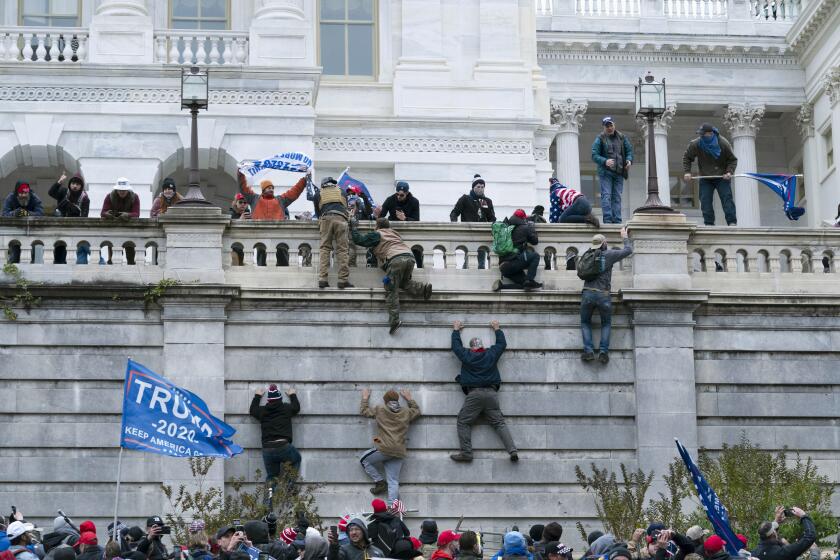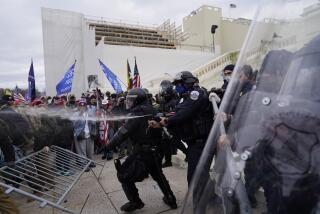Opinion: Post-election violence is likely. Here’s how to contain it

- Share via
I was asked to join a group run by the U.S. government called the Political Instability Task Force in 2017, nearly 30 years into a career that involves thinking and writing about political violence. One of the task force’s goals was to come up with a model to help the government predict what countries around the world were likely to experience political instability and violence within the next two years.
It turns out that two factors were highly predictive. The first was whether a country’s government was an anocracy. These types of governments are also called partial or weak democracies, illiberal democracies, electoral autocracies or hybrid regimes, meaning they have some combination of democratic and authoritarian elements.
The second factor was whether voters in these anocracies had formed political parties around race, religion or ethnicity, rather than ideology. So rather than joining a party because you are conservative or liberal, you join a party because you are Black or white, Christian or Muslim, Serb or Croat.
As Trump’s lies reverberate, our allies question not only U.S. policies but our nation’s fundamental reliability as a partner in the world.
If a country had these two features, the task force considered it at high risk of political instability and/or violence within the next two years and put it on a watchlist.
Based on this model, where is the United States?
Democracy in the United States has weakened since 2016. It was downgraded on the Center for Systemic Peace’s democracy scale for the first time that year after international election monitors deemed our 2016 election free but not entirely fair. It was downgraded twice after that, most recently at the end of 2020, after a sitting president refused to accept the outcome of an election and actively tried to overturn the results, for the first time in U.S. history. By December 2020, U.S. democracy was officially considered an anocracy using the task force’s definition.
The two main parties in the United States have also become increasingly divided by race and religion. Today, African Americans, Latinos, Jews, Muslims and atheists vote predominantly for the Democratic Party, while white people and evangelical Christians vote overwhelmingly for the Republican Party. Based on the task force’s model, at the end of 2020 the United States came dangerously close to having the two features putting it at high risk of political violence. A few weeks later, the insurrection at the U.S. Capitol occurred.
Americans on the left and the right are starting to arm themselves against perceived threats of political violence.
The United States’ democracy score has improved slightly since then, but only because former President Trump left office voluntarily and was succeeded by an administration committed to democracy and the rule of law. Our political institutions and democratic safeguards remain as fragile as — if not more so than — they were on Jan. 6, 2021. Now, the fate of our democracy rests heavily on who occupies the White House, which is a deeply concerning reality.
People have been asking me whether there will be violence again after this year’s election, especially if Trump loses. If Trump loses, violence will almost certainly occur, and that’s because the United States has all the conditions that make election violence likely: winner-take-all elections, deeply divided parties who distrust each other, and one party that has been primed to believe that the election must have been stolen if they lose.
In this scenario, violence could start with protests over the election results and quickly escalate into riots. Far-right militias might join in, first targeting those they see as traitors within their own party. They would likely expand their attacks to include Democratic Party leaders, election officials, law enforcement and anyone upholding the law. Minority groups living in swing states and in blue cities within red states would be at high risk, including Jewish residents in the suburbs of Philadelphia and Pittsburgh, African Americans in places like Detroit and Latinos in Tucson.
For the first time since the end of Jim Crow, substantial numbers of Americans are considering fleeing jurisdictions where legalized vigilantism imperils their lives.
If Trump wins, the immediate aftermath is likely to be less violent. Democrats haven’t been groomed to see a Kamala Harris loss as evidence of cheating, nor have they been encouraged to use violence if Trump prevails. Additionally, the left has far fewer militias ready to take up arms. However, violence from the left is likely to grow if Trump solidifies his power and either cancels future elections or rigs the system to ensure he can’t lose again.
In the long run, a Trump victory is likely to spark more violence for two key reasons. First, history shows that groups permanently shut out of political power are the most likely to rise against the government. Trump has told people they won’t have to vote again if he wins. If he followed through on that and the GOP maintained white voters’ power even after white people became a minority of the electorate, many groups would increasingly resent their lack of representation, a recipe for violence. Second, violence often breaks out when peaceful protests face harsh government crackdowns — and Trump has signaled a willingness to use military force against Americans who demonstrate.
What can we, as individuals, do to prevent or contain violence? If Trump is defeated, the weeks and months that follow will likely see angry extremists and aspiring autocrats lashing out, spreading fear and warning of impending disaster. They will try to create chaos, aiming to make average Americans panic in the face of threats, bomb scares and even assassination attempts. Their goal will be to intimidate us into submission and then convince us that only strongmen can restore order.
Our job is to not panic. We will need to be tough and resilient in the face of these intimidation strategies, to not allow the fear and violence to tear us apart during what I think will be a temporary and containable storm.
If Trump wins and takes steps to dismantle institutions, we will need to become more active. First, we will need to fight with every legal means at our disposal and prepare for peaceful resistance. Most Americans have no experience with sustained protest and will need to learn what works, what doesn’t work and how to use their voice to take back their political power.
As we finally close out a tempestuous campaign season, it’s important for Americans to know that peaceful protest can be a powerful tool for removing autocrats — but only if citizens are ready to act when the moment demands it.
Barbara F. Walter is a professor of international relations at UC San Diego and the author of “How Civil Wars Start: And How to Stop Them.”
More to Read
A cure for the common opinion
Get thought-provoking perspectives with our weekly newsletter.
You may occasionally receive promotional content from the Los Angeles Times.












